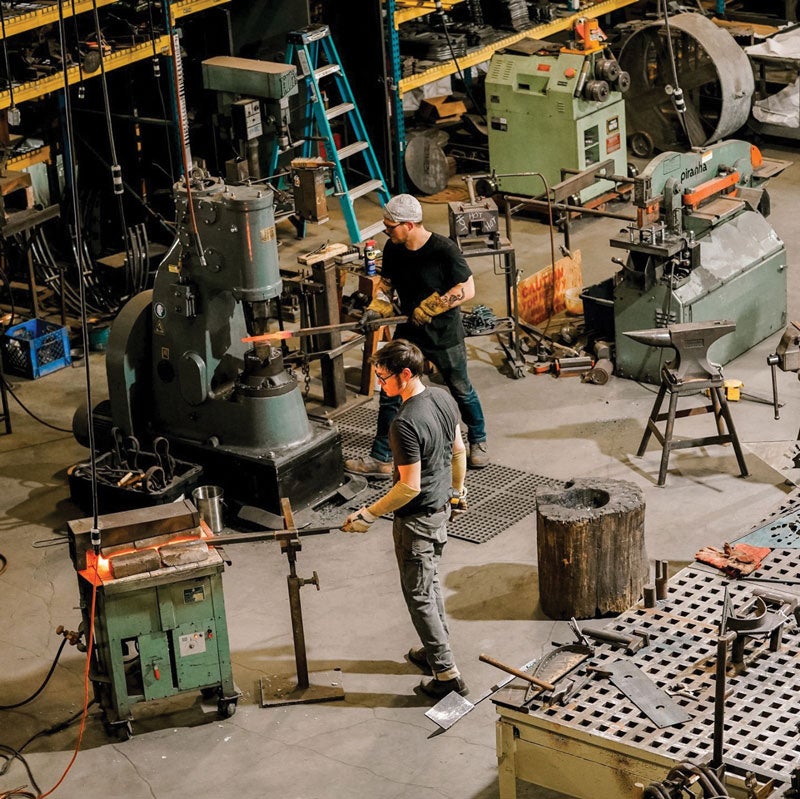Tame the Flame
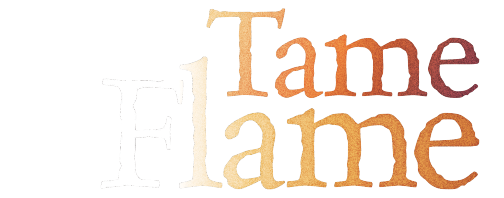
Charles Darwin considered fire and language the two most important discoveries of humankind. Of those, fire has been a symbol of destruction and creation. We admire its beauty, fear its destructiveness and harness its power. East interviewed two groups of people whose careers revolve around fire: firefighters and artists. They describe how they found their calling to work with and around fire and the passions that drive them to continue their work.
The front lines of firefighting
When the alarm rings, they spring into action. With sirens blaring and lights flashing, they rush toward danger while others flee from it. They face smoke, flames and the unknown with courage and selflessness. They are firefighters, the people who put their lives on the line to protect our communities.
Beyond the iconic image of firefighters battling infernos, there is a story of sacrifice, camaraderie and resilience. Kevin Fontana ’94 ’03, Lauren Griffin ’13 ’14 and Derrick Ingram ’00 have more than 60 years of firefighting experience among them.
You might recognize Ingram’s name. He’s in the ECU Athletics Hall of Fame for his track accomplishments in the 1990s. “I was looking for a career job in the Greenville area that would help me provide for my family,” he says. “I met a former Greenville Fire/Rescue employee who told all the great things GFR had to offer. I applied the next day.”
Now a captain with the department, Ingram says the rewards come from knowing he’s “helping people in their time of need. I enjoy helping and providing education to the citizens of this city.”
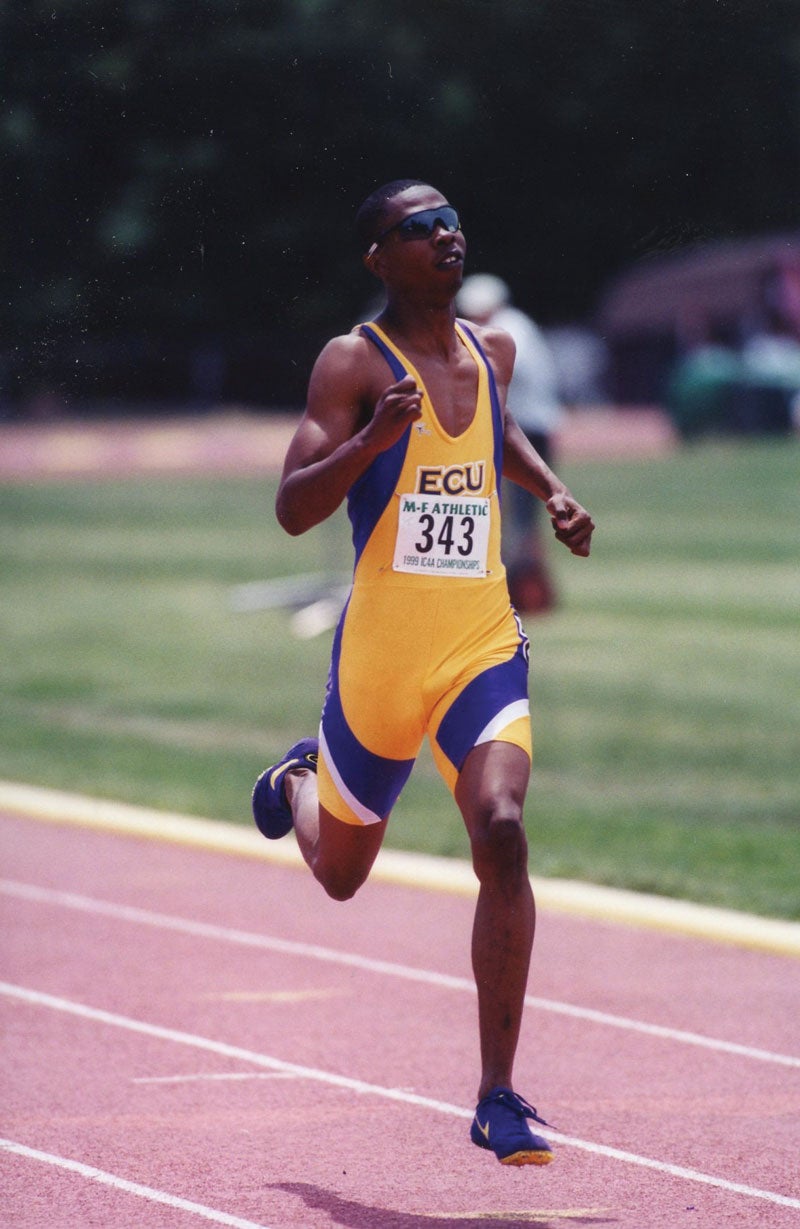
Derrick Ingram ’00
Griffin started firefighting when she was in high school in northern Virginia. Her curriculum required volunteer hours, so she became a junior firefighter.
“I was an overachiever, so I got like 10,000 hours,” she says. Even though music was her focus as a youth, she eventually received degrees in education and counseling at ECU. She taught with Pitt County Schools for seven years as an English teacher and counselor, but she missed firefighting.
During a vacation to Belize, a nearby restaurant caught fire. Griffin got in the bucket brigade ferrying water from the ocean to douse the flames. Inside her head, a voice kept talking. After returning home, she saw an ad for a career fair at GFR.
“That little voice says you need to do fire and rescue,” she says. “I haven’t looked back. I just had a calling. Every year I was without fire and rescue in my life, there was something missing.” She’s also a paramedic.
For Fontana, it was seeing volunteer firefighters work to save a neighbor’s burning house — community members who had also helped his family during difficult times. He was 20 at the time and talked with one of the firefighters afterward.

Jessica Blackwell ’17
“I thought volunteering would be a way to repay the community for supporting my family,” says Fontana, who’s an instructor in the College of Business.
Keeping your cool when things get hot
In 2022, GFR responded to 74 building fires and 55 cooking fires confined to a container, according to Jessica Blackwell ’17, public information officer and fire educator. For all types of fires, from vegetation to vehicles, firefighters responded to 148 fires in 2022 and 174 in 2021. According to the National Fire Protection Association, every 23 seconds, a fire department in the United States responds to a fire somewhere in the nation.
For firefighters, staying calm at a fire scene is a matter of training and experience. Griffin says yoga also helps. “Some people get really excited, overenergized, but I find a calming in putting on my gear, breathing,” she says. “I’ll constantly monitor my breathing, bring my heart rate down, conserve my air. But it’s also an adrenaline rush. Within five to 10 minutes, the main job is done, but it’s so physically strenuous.”
How strenuous? She says not as much as moving into Legacy Hall as an 18-year-old. “Walking up all the stairs — I still remember the day my parents helped me move into that dorm. Lugging all that equipment is nothing compared to moving into my dorm,” she says with a laugh.
“I try to lean back on my fire training to manage my emotions at incident scenes,” Ingram says. “I don’t think I have ever been scared due to training.”
Looking ahead
Firefighting jobs are expected to grow at about a 4% rate through 2031, most with local departments, according to the federal Bureau of Labor Statistics. That means about 28,000 openings each year to replace workers who retire, move to other jobs or leave the workforce.
- Install and regularly test smoke alarms on every level of your home, inside bedrooms and outside sleeping areas.
- Talk with all family members about a fire escape plan and practice the plan twice a year.
- If a fire occurs, get out, stay out and call for help. Don’t go back inside.
- Have a fire extinguisher and learn how to use it.
Sources: American Red Cross, FireRescue1
Griffin’s 7-year-old son, Asher, wants to follow in his mom’s footsteps.
“He wants to be a firefighter,” she says.
Fontana is coming out of a recent volunteer hiatus due to family illness and preparing for his daughter’s wedding. He plans to pick up his volunteer work this summer. Why? He goes back to that day 30 years ago when he saw local men and women risk their lives.
“It’s all about public service and the importance of volunteering to help your community,” he says. “Volunteer firefighter numbers are down across the state. If I can help sound the alarm — pardon the pun — I will do so when possible.”
Pottery tells Owen’s multigenerational story
Committing pottery to the fire is one chapter in a unique story of each piece. Flame, heat and time change the clay and glaze, creating vessels with color, character and texture. It’s a story Ben Owen III’s family has told for generations in Seagrove.
Owen ’93 says his work is at the mercy of the fire when placed in a wood-fired kiln, where flame surrounds the vessels. Smoke and ash can also affect the glazes and can change the state of the materials in the glaze. Owen finds the interaction and the outcome exciting. He’s spent years studying to enrich his craft.
“I learned my craft the traditional way, passed down from my family and other potters in the area, not relying on modern technology,” Owen says. “I wanted to understand why all these things worked the way they did and how our family manipulated these materials, transforming a lump of clay into a vessel of purpose.”
Owen brought his family knowledge to ECU to study under professors and artists, including Art Haney and Chuck Chamberlain. As a student, he was indulged with access to labs, freedom to do research and the opportunity to learn how different materials work. Owen focused on ceramics but took on a well-rounded curriculum that allowed him to look at what he did with clay in interaction with other elements, such as woodworking, painting and blacksmithing. For Owen, it added depth to his knowledge of pottery.
“ECU had such a great foundation of materials and equipment to use, plus we had the opportunity to build a wood kiln while learning the fundamentals of how to control the fire successfully,” Owen says.

Ben Owen emerges with a vase
from a wood kiln firing at Ben
Owen Pottery in Seagrove.
Every firing is different, and each piece has a unique mark from the firing.
Ben Owen III
Owen describes a wood kiln firing as a performance. Each performance inspires Owen’s journey of creating pieces that will be in the next story. A couple of months of work go into wood firing. He typically prepares four or five wood firings a year — dictated by what he makes and commission work as needed. Each firing can include 300-400 pieces. A larger kiln has the capacity for up to 1,500 pieces.
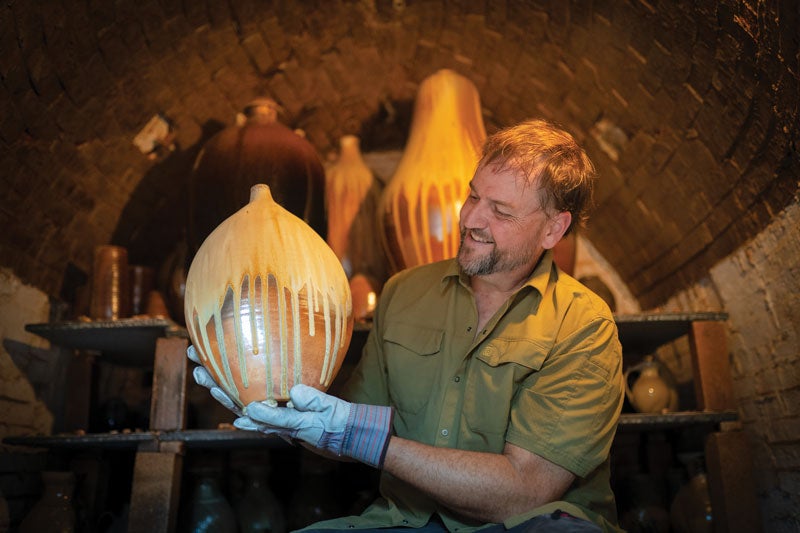

Ben Owen retrieves vessels from the kiln, where his work is at the mercy of the fire. Every firing is different, and each piece has a unique mark from the firing.
“You set out a goal and a road map for what you want for the pieces and how you think it will turn out. Just when you are sure how the results may be, the firing, materials, weather or plan provides the unexpected,” Owen says. “Every firing is different, and each piece has a unique mark from the firing. I still get nervous but excited every time we reveal the results from the process.”
The flames, heat and artistry of an iron pour sparked the imaginations of Aaron Earley ’10, James Dudley ’11 and Ella Snow ’17 and eventually fused them together as partners and staff at Cricket Forge in Durham.
The attraction to sculpture and fire began for them as students at ECU’s School of Art and Design. Iron pours are a team effort, “a sort of dance to create art,” Dudley says. Iron is melted to 3,000 degrees Fahrenheit, collected and poured into wood and sand molds for iron casting. The wood burns, and sand and wood fuse with the cooling iron, creating the cast sculpture.
“It was a thing we practiced at ECU and hardly anywhere else at the time,” Earley says.
“It was the most amazing thing I had ever seen,” Dudley says. “All I knew was I needed to do this. Whatever this is, this is my future.”
At Cricket Forge, the trio and their co-workers are still drawn to the flames and heat. They specialize in metal art furnishings, steel indoor and outdoor furniture, garden benches, custom metal work and sculpture. Earley and Dudley became owners of the business with partner Jonathan Paschall. Snow joined in 2021.
Each day is a mixture of small-business management, maintenance, marketing, customer service, fabrication and creation. In the creation of their production and custom work, fire is the creator, manipulator and finisher of their art. They work with plasma energy, heat treatments and traditional blacksmith forging in the facility. “It’s essentially a handheld flame thrower with a metal wire thrown in,” Snow says. Propane and oxygen feed into the sprayer to create the fire. Zinc wire meets the flame, melts and sprays onto the metal work. “It looks like it should be a prop in a space movie with constant flame coming out of the front as you coat the surface of the product.”
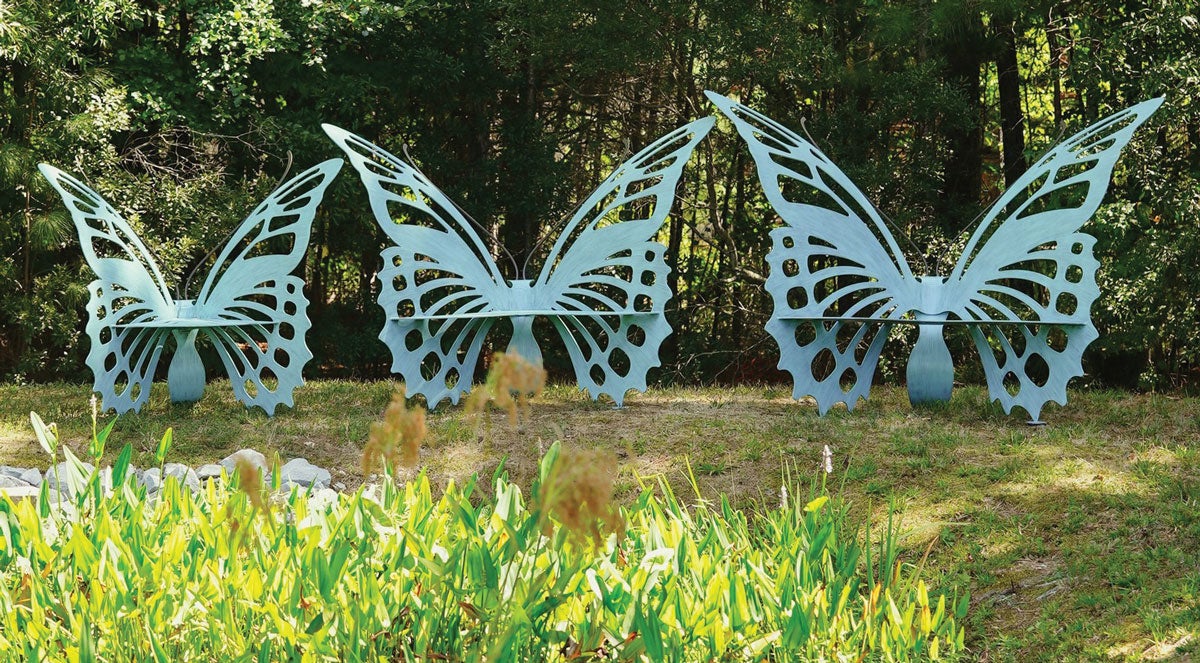
Cricket Forge staff partnered with Don Drumm Studios on the fabrication and assembly of Drumm’s sculpture Sun Tracker. The piece stands at over 18 feet tall, is built from 5/8-inch stainless steel sheet and is on display in Akron, Ohio.
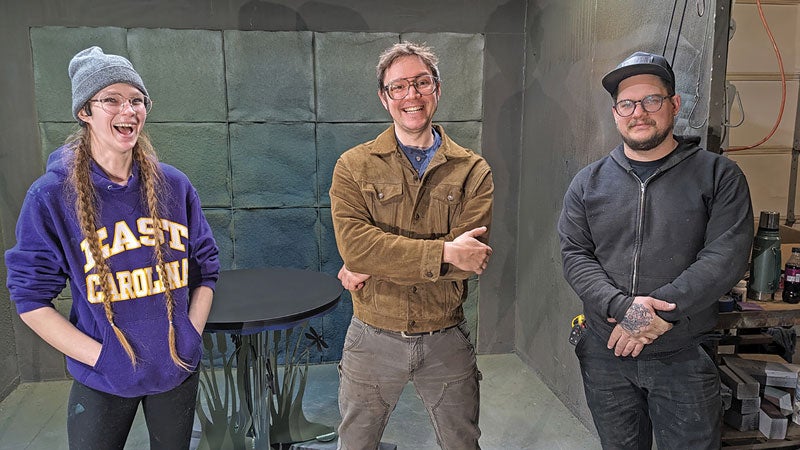
ECU School of Art and Design graduates, from left, Ella Snow, Aaron Earley and James Dudley are drawn to the flames and heat in their work at Cricket Forge in Durham.
As a co-owner and fabricator, Dudley is working with metal as he always knew he was meant to. His work often includes creating tools used at Cricket Forge. He also works with clients to design custom work and maintains the shop equipment and infrastructure.
“You can’t help but be inspired by what you see in the shop,” Dudley says. “We create a lot of scrap metal whose shapes have influenced countless artists outside of Cricket Forge in creating their own art.”
One of the things we’ve carried with us from ECU is that sense of community and how to work as a team.
Aaron Earley, co-owner of Cricket Forge
Over 24 years, the butterflies and creations of Cricket Forge have found homes across the country, including the entirety of the Duke University campus. Earley also has seen one of their sculptures installed at an overlook on the side of a mountain.
